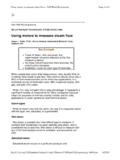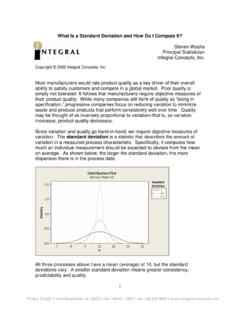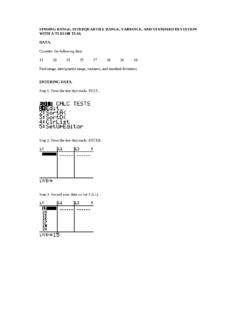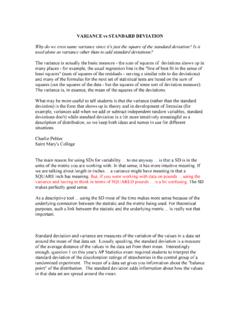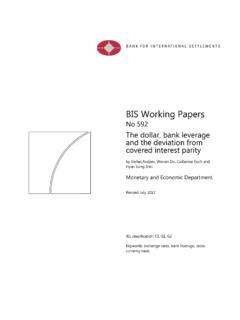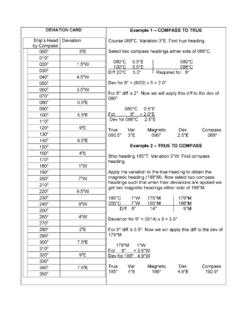Transcription of Flowmeter Calibration: How, Why, and Where …
1 Flowmeter calibration : How, Why, and Where Here's What Happens When You Send Your Flowmeter Out to a Major calibration Lab By Jesse Yoder August 01, 2000 So you just got that new Flowmeter and you are about to install it. How do you know it's accurate? How accurate? Flowmeter calibration answers these questions. But what is calibration , and how is it applied to flowmeters? One dictionary defines "to calibrate" as "to standardize (as a measuring instrument) by determining the deviation from a standard so as to ascertain the proper correction factors." There are two key elements to this definition: determining the deviation from a standard, and ascertaining the proper correction factors. Deviation From a Standard To measure deviation, it is first vitally important to determine the actual flowrate.
2 In Flowmeter calibration , this is normally done by one of two methods: using a master meter, or weighing the flow to get a gravimetric reading of mass flow. A master meter is a Flowmeter that has been calibrated to a very high degree of accuracy. Types of flowmeters used as master meters include turbine meters, positive displacement meters, venturi meters, and Coriolis meters. In the , master meters are often calibrated at a flow lab that has been certified by the National Institute of Standards and Technology (NIST). NIST certification of a Flowmeter lab means that its methods have been approved by NIST. Normally, this includes NIST traceability, meaning that the standards used in the Flowmeter calibration process have been certified by NIST or are causally linked back to standards that have been approved by NIST.
3 The second method involves gravimetric weighing of the amount of fluid (liquid or gas) that actually flows through the meter into or out of a container during the calibration procedure. This is normally done using a weigh scale that has a very high degree of accuracy. Just as a master meter needs to be traceable to NIST, the weigh scale must be approved by NIST or calibrated using standards traceable to NIST. The gravimetric method is generally regarded as the most accurate way to measure the actual amount of flow. Correction Factors The second component of calibration is determining the proper correction factors. It is easy to think of Flowmeter calibration in terms of adjusting a bathroom scale, Where we simply use a knob to zero the scale when there is no weight on it. Once this adjustment is made, the scale is "calibrated" and we may then assume that it reads correctly.
4 But you may notice that you always seem to weigh more on your own scale than you do at your health club. Both scales may be zero-adjusted, yet one may consistently give higher weight readings than the other. It is easy to see how to resolve a dispute between two scales. Bring them both together, and compare them to a certified scale that you know is highly accurate. But suppose one scale consistently weights two pounds heavy? Or, perhaps it weighs one pound heavy up to 80 pounds, pounds heavy up to 130 pounds, and two pounds heavy beyond 130 pounds. How do you correct this scale? There are some parallels to Flowmeter calibration , since getting a Flowmeter to read zero flow under no-flow conditions may be part of the calibration process, and is not always as simple as it sounds. There is often no simple hardware adjustment to make the Flowmeter start reading correctly.
5 Instead, the deviation from the correct reading is recorded at a variety of flowrates. The data points are plotted, comparing the Flowmeter output to the actual flowrate as determined by the master meter or weigh scale. In many cases, the data reflecting Flowmeter performance at a range of flowrates is made available to the end user. This data may also be used to create a compensating formula so the user can determine the flowrate within a specified range of accuracy. This compensating formula is parallel to the instruction, "Add two pounds to the weight of the scale," which represents a simple correction formula for a scale. But usually it will be more complex, since Flowmeter performance often varies at different flowrates. For example, many flowmeters have a more difficult time accurately measuring low flowrates than they do higher flowrates.
6 Your Calibrated Flowmeter Once your Flowmeter is calibrated, it may still read exactly the same under the same flow conditions as it did before it was calibrated. The difference is that you will know exactly how close those values are to the true values, and you will have a formula to use to calculate the true values from the actual values read by your Flowmeter . Of course, if your Flowmeter was inaccurate because of some correctable hardware problem or because it was programmed incorrectly to begin with, your newly calibrated Flowmeter may read much more accurately than it did before. This could happen to an orifice-plate Flowmeter if the plate was positioned improperly or to an ultrasonic Flowmeter if one of the ultrasonic beams was not being included in the flowrate calculation. There are many different reasons why a Flowmeter might read improperly, and some are correctable.
7 But even if a deviation is not correctable by a hardware adjustment or by reprogramming, your Flowmeter can still provide highly accurate readings once it has been calibrated so you can make the necessary adjustments to the output values. When and Why There is no simple rule to determine when to calibrate a Flowmeter , since calibration factors are highly relative to the specific Flowmeter technology. For example, orifice plates are subject to wear and need to be checked periodically for accuracy. This period could be once a year, but it depends on the type of fluid being measured and whether the fluid is clean or dirty. Flowmeters with moving parts, such as turbine and positive-displacement meters, need to be calibrated periodically to determine the effects of wear on the meters. Many experts believe that ultrasonic flowmeters used to measure natural gas should be calibrated before they are put into service.
8 Once they are in service, however, calibration requirements are minimal since these meters do not have moving parts and are not subject to wear. If you are in doubt about your type of Flowmeter , check with your supplier or a Flowmeter expert for advice about calibration . Table I lists different types of flowmeters and gives reasons why each type may need calibration . A Sampling of Labs Many Flowmeter suppliers maintain an onsite laboratory for calibration purposes, and some end users maintain their own facilities and perform their own Flowmeter calibration . But if you need to send a Flowmeter to an outside laboratory for calibration , there are some excellent facilities in the Three of the best are Colorado Engineering Experimental Station (CEESI), Nunn, Colo.; CEESI Iowa, Clear Lake, Iowa, and Southwest Research Institute, San Antonio, Texas.
9 I recently visited these three facilities to get a better perspective on Flowmeter calibration . I found that each lab has its own history, its strengths, and its areas of specialization. The history of CEESI Colorado begins in 1951, when it began operation as a program of the College of Engineering of the University of Colorado at Boulder. The program was concerned with researching and testing small rockets for the Naval Ordinance Test Station at China Lake, Calif. In the 1950s, the station was the only one used by the military to test turbine flowmeters. In 1966, CEESI moved to its present location, which is an abandoned Atlas missile site. In 1986, Steve Caldwell and Walt Seidl purchased the facility and turned it into a commercial calibration laboratory. CEESI specializes in testing and calibrating a variety of types of flowmeters including ultrasonic, Coriolis, magnetic, positive-displacement, turbine, vortex, and differential-pressure (Figure 1).
10 The facility also tests many types of valves, including control, ball, safety relief, check, and plug valves. CEESI can test and calibrate both liquid and gas flowmeters. A Brooks Compact Prover is used for volumetric liquid tests, while turbine meters are used as transfer standards. CEESI also has three different gravimetric water systems: low range weighs 50 pounds of water, midrange weighs 1,200 pounds of water, and high range weighs 16,000 pounds of water (Figure 2). For gas flow, CEESI has numerous test areas to accommodate varying test conditions. In addition to the numerous secondary systems, three primary systems are currently in use. A fourth system that combines the PVTt and Mass Time methods will be operational this year. The CEESI Iowa facility was built recently to provide a location for testing and calibrating ultrasonic natural gas flowmeters.
